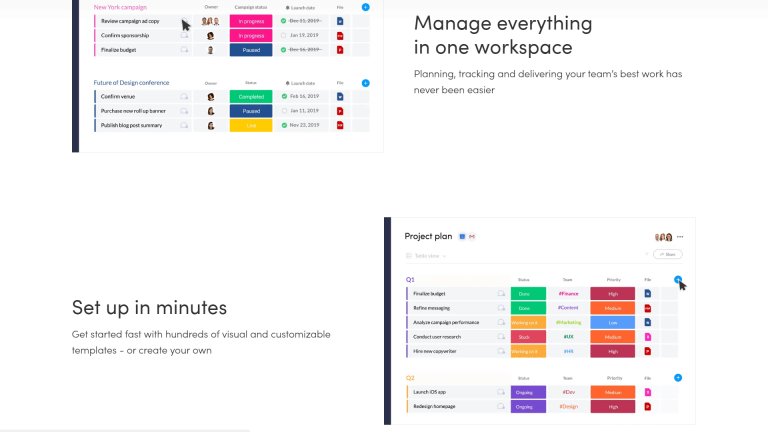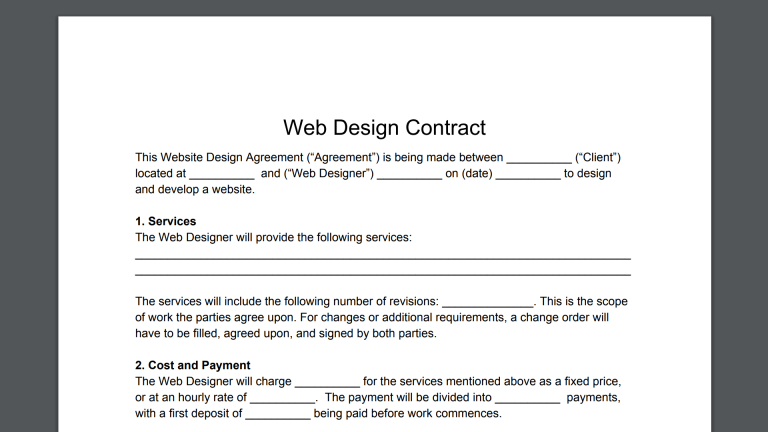Table of Contents
The ability to ensure that everyone (and especially the client) is satisfied with the final outcome of a web design project is one of the major factors determining a project’s success.
Unfortunately, overlooking important preparatory steps, like setting project deliverables, for example, can lead to complications down the road.
One way to ensure that a project goes smoothly is by setting and managing client expectations. While there can be quite a few steps that take some time and effort, doing the necessary due diligence can prevent friction in the long run and keep your reputation stellar.
In this article, we’ll discuss why it’s important to set and manage client expectations during your onboarding process. We’ll also provide you with some tips for going about it. Let’s get to it!
The Value in Setting and Managing Client Expectations During Onboarding
The client onboarding process is a crucial part of establishing a solid working client relationship. Optimizing this process will require setting and managing expectations on both sides. For starters, you’ll need to get to know and understand each other.
It’s smart to learn what your new clients want out of the project. This means digging into their vision, mission, values, and more. However, you also want to ensure that they have realistic expectations of the web design process and its final output.
Establishing what the project deliverables will be, your clients’ expectations regarding the timeline, and similar factors will help keep everyone on the same page. Clarifying these important details as early on as possible is crucial.
Essentially, setting expectations ensures that everyone – you, your team, and the client – share a common vision of the project. This can help prevent misunderstandings and even scope creep.
10 Key Tips for Setting Client Expectations in Web Design
Setting and managing client expectations for a web design project can be tricky. Fortunately, we’ve put together a list of ten tips to make it easier. Let’s dive in!
1. Identify the Type of Client You’re Working With
Before you begin to set expectations, it’s smart to first and understand the type of client you’re working with. You want to be aware of this early enough so that you can make a decision about whether or not to stay on.
When your team is hired for a project, it’s because the client sees you as an expert. However, there’s no guide for how to be a client. Therefore, it’s in your best interests to learn how to manage them. Identifying the type you’re working with can help you better deal with them and tackle issues such as scope creep.
For example, let’s consider the curious client. This type of client is genuinely interested in your work and wants to be involved as much as possible. They’ll often ask many questions and request multiple reviews over the course of the project. You’ll want to start by understanding their working style and setting limits or boundaries in your contract. You could also plan a meeting to address their questions or provide them with a website design questionnaire.
Another common example is the know-it-all. This type generally thinks they can do your work better than you, and won’t hesitate to let you know it. There’s also the underling who is devoted to the project and provides instant feedback. However, they lack the authority to approve anything. You want to manage this by ensuring you know the key stakeholders, so you can keep the project from stalling.
Regardless of the type of client, you’re working with, there are usually effective steps you can take to healthily manage the relationship. The key is identifying and anticipating their needs.
2. Establish the Client’s Goals and Objectives for the Project
Next, you’ll want to get your client to articulate their goals and objectives for the project. This can help you sort out project expectations and might involve learning about their company, target audience, business model, and more. This is a hurdle you want to cross early, as it can ensure that your design fulfills or even surpasses the original vision.
Once you have a list of the necessary details, you’ll want to include them in the web design brief. This provides easy reference material for ensuring that everyone’s vision of the final outcome is shared.
When it comes to setting and managing client expectations, it’s helpful to anticipate their needs. This can take time and will require practice. Additionally, you’ll want to be aware of when things are going great, and when you might need to put in some extra effort.
Some tips that can smoothen this step include asking questions and listening. Also, you don’t want to take answers at face value. Instead, consider how each concern might affect the project, and follow up with more questions if necessary.
3. Clearly Define Project Deliverables
Once you’ve established the goals and objectives of your project, the next practical step is to define all the required or expected deliverables. These will determine when the design can be considered a success, and can also help the client envision what to expect at the end of the process.
Examples of project deliverables can include design mockups, software documentation, prototypes, the website itself, or something else. Regardless of what it is, clearly-defined artifacts can help to ensure that the team fully understands what is required to meet the client’s expectations.
4. Create a Detailed Plan for Completing Tasks
Effective project management is necessary when multiple people are working on a project. The entire effort needs to be coordinated. Therefore, consider creating a detailed plan of action along with timelines. This will make it easy to keep the client informed about project status at all times.
The plan should outline not just deadlines that need to be met, but also all the required deliverables. You might want to consider using a project management app such as Trello or Monday to create shared to-do lists that track tasks, milestones, and all important deliverables:

This can ensure that everyone knows what to do, who’s responsible, and when it should be completed. Keeping everyone informed and updated is an effective way to prevent unnecessary miscommunications and to help your web design clients maintain a realistic expectation of deliverables.
5. Set Realistic Expectations and Be Transparent About What Can Be Accomplished
It is important to be upfront from the get-go and aim for under-promising versus over-delivering. Be clear about what you can and can’t do. For example, you can design a website, but it’s disingenuous to guarantee that it will increase Return on Investment (ROI) by 30 percent.
Additionally, you want to clarify the limits of the project and make sure the client is aware that some aspects, such as timeline and scope, might change as the project advances. It can be helpful to have case studies on hand to show that you can accomplish the end goal even if modifications are required.
Finally, give your client some promises you’ll adhere to, such as discussing why an out-of-scope item is beyond the limits of the project, getting written approval before doing work that might incur additional costs, and so on. This might even include something as simple as promising to respond to emails within 24 hours.
6. Keep the Lines of Communication Open
This is one of the most important tips on our list. Keeping the lines of communication open between your team and your client can prevent misunderstandings and smooth feathers before they’re even ruffled.
As a project manager, good communication cannot be overemphasized. You want to encourage over-communication so that your team and the client always know what is happening. Plus, your customers need to know that they can reach you when required. It might even be helpful to specify a point of contact in case of emergencies.
In a nutshell, outlining and discussing a client’s expectations can be reassuring to them, because it can alleviate and prevent unwelcome surprises from cropping up. They’ll also be happy to be kept in the loop at each step of the design process.
7. Establish Limits and Boundaries
It is easier to manage expectations when you set limits and boundaries. In general, you want to make sure everyone is focused on the same goals and that you can always redirect the client toward the original vision of the project if there’s even a slight possibility that they might derail it.
You want to stay firm when needed and not agree to every client request. This can help you keep unrealistic expectations in check. In the same vein is setting expectations regarding how you work. For example, if you’re not prepared to work on weekends, you’ll need to communicate that in advance.
8. Conduct Status Meetings
We’ve already mentioned the importance of keeping the client in the loop at each stage of the project. This is something you want to be proactive about. Regular status meetings can provide the client with reports about what features or tasks have been completed or are still pending.
Keeping your clients informed this way can be reassuring, as they can see what they’re paying for. Additionally, it can help reaffirm expectations established at the start of the project. Note that the reports you prepare can be as simple as emails detailing completed tasks.
During these conversations with the client, be sure to refer to the original goals for the project. For example, if the client asks for last-minute changes, help them understand how that might impact the project in its entirety, and whether or not it will further their objectives.
Finally, don’t be afraid to deliver bad news. If something’s wrong, it’s usually better to make it known. You could add a ‘risks’ or ‘obstacles’ section in your status report, so you don’t surprise your client with news that the project has overshot its budget or is running late.
9. Make Sure to Sign a Contract
It’s important to get everything that has been agreed to in writing. This includes the project’s goals, what you can deliver, promises you make, all relevant deliverables, the scope of the project (what is within or outside limits), post-launch services, and more:

A web design contract can protect you if your client is suddenly reneging on making payments, or seems to expect you to work weekends even though you didn’t agree to that. It can also protect you when it comes to scope creep. This is why you’ll want to be prepared to enforce the agreed terms if necessary.
10. Be Clear on What Happens If Plans Change
Last but not least, you’ll need to help your client understand that things might not always go smoothly. There will probably be setbacks. However, it’s important for them to know they can trust that any such roadblocks will be handled efficiently.
For example, you might state that if approvals are missed, the timeline will be pushed back a day to reflect the delay. You could also list out all the possible risks, how you’re working to prevent them from holding up the project, and what your backup plan is.
Overall, you want your client to be fully confident in your ability to manage and bring their project to fruition. However, they also need to have realistic expectations. Informing them about this right from the start can ensure they do not begin to panic when something falls out of place.
Set and Manage Client Expectations Effectively
Your relationship with your client can turn out to be a minefield if expectations are not set and managed properly. There’s a lot at stake for both yourself and them, so it is important that a foundation for success is established right from the onboarding stage.
In this article, we’ve discussed ten tips you can use to set and manage client expectations effectively. They include identifying the type of client you’re working with, defining project deliverables clearly, conducting status meetings, and more.
What tips are you most excited to implement in your next client onboarding process? Share them with us in the comments section below!
Looking for fresh content?
By entering your email, you agree to receive Elementor emails, including marketing emails,
and agree to our Terms & Conditions and Privacy Policy.






